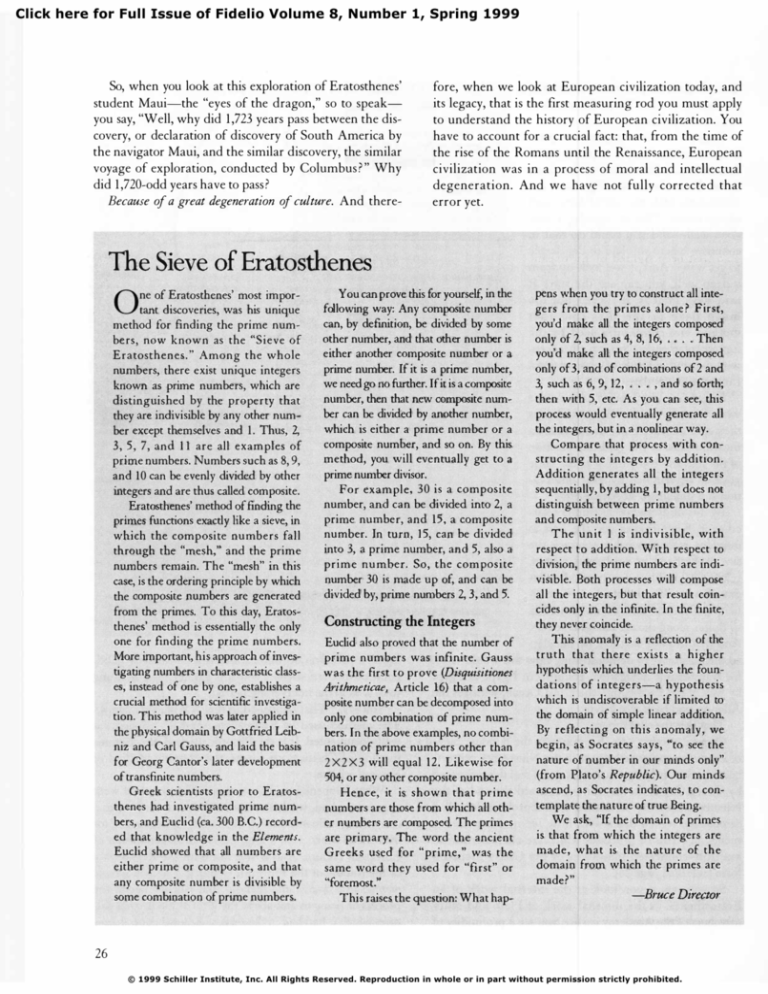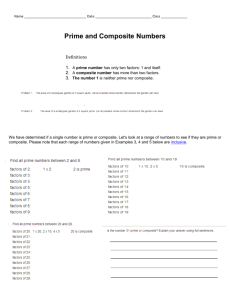
Click here for Full Issue of Fidelio Volume 8, Number 1, Spring 1999
So, when you look at this exploration of Eratosthenes'
student Maui-the "eyes of the dragon," so to speak­
you say, "Well, why did 1 ,723 years pass between the dis­
covery, or declaration of discovery of South America by
the navigator Maui, and the similar discovery, the similar
voyage of exploration, conducted by Columbus ? " Why
did 1 ,720-odd years have to pass ?
Because of a great degeneration of culture. And there-
fore, when we look at European civilization today, and
its legacy, that is the first measuring rod you must apply
to understand the history of European civilization. You
have to account for a crucial fact: that, from the time of
the rise of the Romans until the Renaissance, European
civilization was in a process of moral and intellectual
degeneration. And we have not ful l y corrected that
error yet.
The Sieve of Eratosthenes
O
ne of Eratosthenes' most i m por ­
tant discoveries, was his unique
method for fin d i n g the
p r i m e num­
You can prove this for yourself, in the
pens when you try to construct all inte­
can, by definition, be divided by some
you'd make all the integers composed
following way: Any composite number
and that other number is
be r s , now k n o w n as the " S i e v e o f
other number,
Eratosthenes . " Among the
e ither another composite number or a
whole
numbers, there exist unique in tege r s
known as prime num bers , which are
distinguished by the p r o pe rty that
they are indivisible by any other num­
ber except the m selves and 1. Thus, 2,
3 , 5 , 7, an d 1 1 a r e all e x a m p l e s of
prime numbers. Numbers such as 8, 9,
and
10 can
be evenly
divided by othe r
integers and are thus called com posi te .
of finding the
primes functions exactly like a sieve, in
which the composite n u mbe rs fa l l
Eratosthenes' method
through the "mesh," and the prime
numbers re m a i n . The "mesh" in this
case, is the ordering princi ple by which
the composite
numbers are generated
from the primes. To thi s day, Eratos­
thenes' method is essenti al ly the only
one for finding the prime numbers.
More important, his approach of inves­
tigating numbers in characteristic class­
es, instead
c ru c ial
of one by one, establishes a
method for scientific i nvestiga­
tion. This method was later applied in
the physical domain by Gottfried Leib­
niz and Carl Gauss, and laid the basis
for Georg Cantor's later development
of tr an sfi n i te numbers.
Greek sc ie n ti s t s
prior
be divided
by another number,
which is either a pr i m e number or a
is
divisible by
some combination of prime numbers.
only of 2, such as 4, 8, 1 6, .
.
.
Firs t ,
. Then
you'd make all the integers composed
only
of 3, and of combinations of 2 and
6, 9, 1 2 , . . . , and so forth;
3, such as
then with 5, etc. As you can see, this
process would eventually generate all
the i nteger s, but in a n on l i nea r way.
composite number, and so on. By this
Compare that process with con­
m e tho d , you will eventually get to a
structing the i n tege rs by a d d i tion .
prime number divisor.
Addition generates all the intege r s
Fo r
exam ple, 3 0
i s a composite
number, and can be d iv ided into 2, a
sequentially, b y adding 1 , but does not
distinguish between prime numbers
number. In turn , 1 5, can be divided
and composite numbers.
T h e u n i t 1 is i n d i v i s i b l e , w i t h
p r i m e n u m ber.
division, the prime numbers a re indi­
p r i m e numbe r , and 15,
into 3, a prime
a co mpo s i te
number, and 5, also a
So, the c o m p o s i t e
number 30 is made up of, and can be
divided by, prime numbers 2, 3, and
5.
Constructing the Integers
Euclid also proved that the number of
prime numbers was infinite. Gauss
was the first
to
prove
respect t o addition. W i t h respect to
visible. Both p rocesses will compose
all the intege rs , but that result coin­
cides only in the infinite. In the finite,
they never coincide.
(Disquisitiones
This a nomaly is a re flec tion of the
truth that there exists a higher
hypothes i s which underlies the foun­
a com­
d a t i o n s of i n tege r s-a h y p o t h e s i s
only one combination of prime num­
the domain of simple linea r addition.
Arithmeticae,
A r ti c le
posite number can
1 6) that
be decomposed into
bers. In the above examples, no combi­
nation of prime numbers
other than
2 X 2 X 3 will equal 1 2 . L i ke wis e for
504, or any other composi te number.
er numbe r s are composed. The primes
e i the r prime or c om po s i te , and t ha t
i te number
ber can
B.c.) record­
Euclid showed that all numbers are
com po s
number, then that new composite num­
H e n c e , it is s h o w n t h a t p r i m e
ed that knowledge in the Elements.
any
If it is a prime number,
to Eratos ­
thenes had i nv es tigated p ri m e num­
bers, and Euclid (ca. 300
prime number.
we need go no further. If it is a composite
ge rs from the primes a l one ?
numbers are
those from which all oth­
are primary. The word the ancient
G reeks
used fo r " p r i m e , " was the
same word t h e y used for "first" o r
"foremost."
This raises the question: What hap-
which is undiscoverable
if limited
By r e fl e c t i n g on t h i s a n o m a l y ,
to
we
b e g i n , as Socrates says, " to see the
of number in our minds only"
(from Plato's Republic). Our minds
nature
ascend, as Socrates i n d ic a te s , to con­
template the nature of true Being.
We ask,
"If the domain
of p ri mes
is that from which the i ntegers are
m a d e , w h a t is
the n a t u r e of t h e
domain from which the primes are
made ? "
-Bruce Director
26
© 1999 Schiller Institute, Inc. All Rights Reserved. Reproduction in whole or in part without permission strictly prohibited.





